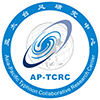AOP-8: Workshop on Parallel Analysis of Satellite Data in Operational Tropical Cyclone Monitoring Successfully Held in Shanghai

From May 29 to 30, 2024, the Asia-Pacific Typhoon Collaborative Research Center (AP-TCRC), successfully hosted the meeting on the theme of "Application of Multi-source Satellite Data in Typhoon Monitoring," part of the WMO/ESCAP Typhoon Committee's Annual Operating Plan(AOP-8) in Shanghai, China. The workshop aimed to enhance the application capabilities of multi-source satellite data for typhoon monitoring and to promote international exchange and cooperation among WMO/ESCAP Typhoon Committee members in the fields of satellite monitoring technology and typhoon monitoring research and development.
At the opening ceremony, speeches were delivered for the international workshop by Deputy Director DAI Kan from the National Meteorological Center, Director XIAN Di from the Science and Technology Department of the National Satellite Meteorological Center, Director TANG Jie from the AP-TCRC, and Secretary-General DUAN Yihong from the WMO/ESCAP Typhoon Committee Secretariat.
The workshop invited a total of 12 overseas representatives from the meteorological departments of South Korea, Hong Kong, Macao, Thailand, the Philippines, Malaysia, and Vietnam, as well as nearly 10 domestic representatives from the National Meteorological Center and the National Satellite Meteorological Center. Distinguished experts and scholars from the National Satellite Meteorological Center, Nanjing Meteorological Science and Technology Innovation Research Institute, and Sun Yat-sen University were specially invited to give keynote speeches, detailing the Fengyun Meteorological Satellites and their applications, as well as the preliminary design for identifying concentric eyewall typhoons.
Dr. Heeyong LEE and Dr. Jinho SHIN from the National Meteorological Satellite Center (NMSC) of South Korea presented on the application of GK2A dynamic elements in typhoon analysis and the research on estimating sea surface wind speed (SSW) using GK2A AMV data. The workshop reports focused on the application of multi-source meteorological satellite data in typhoon monitoring, the application of high-resolution geostationary imagery in typhoon observation, the relationship between the diurnal variation and the structure and intensity changes of tropical cyclones, the automatic analysis model of typhoon centers based on artificial intelligence, and the application of typhoon monitoring and intensity prediction in satellite imagery.
This workshop not only strengthened academic exchanges in the field of typhoon monitoring in the Asia-Pacific region but also provided strong technical support for improving the accuracy and timeliness of typhoon forecasting. The AP-TCRC will continue to commit to promoting typhoon scientific research and international cooperation to jointly address the challenges brought by climate change.
